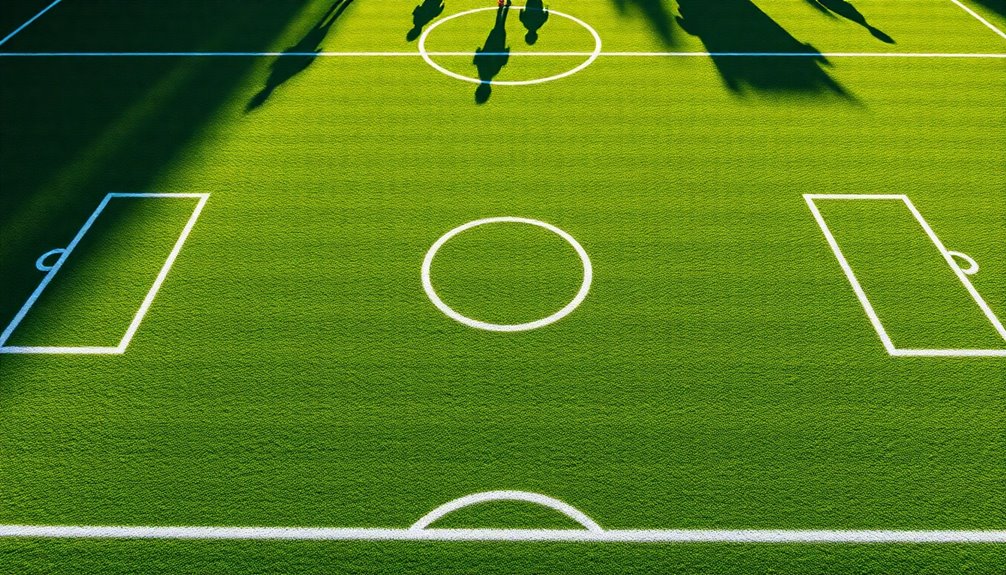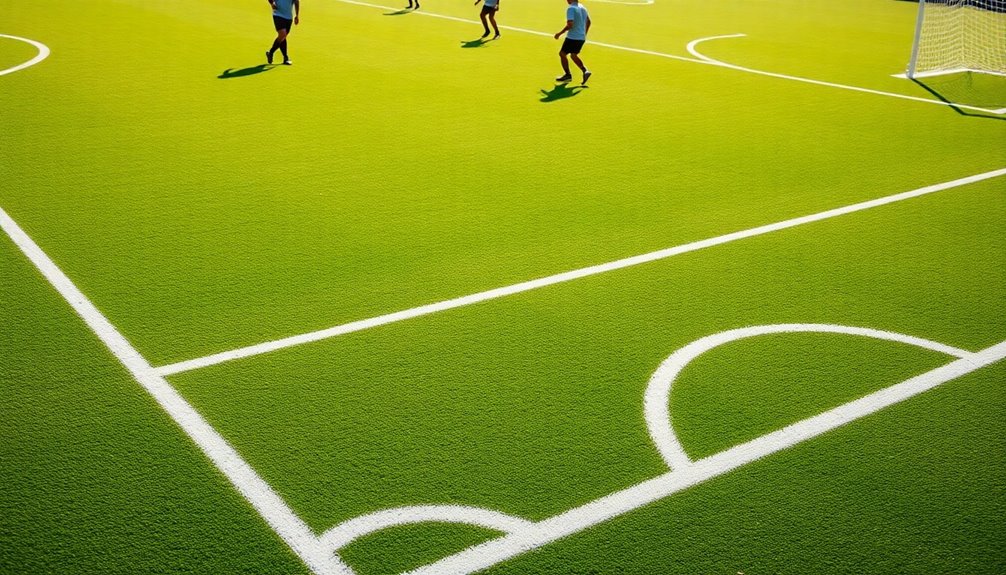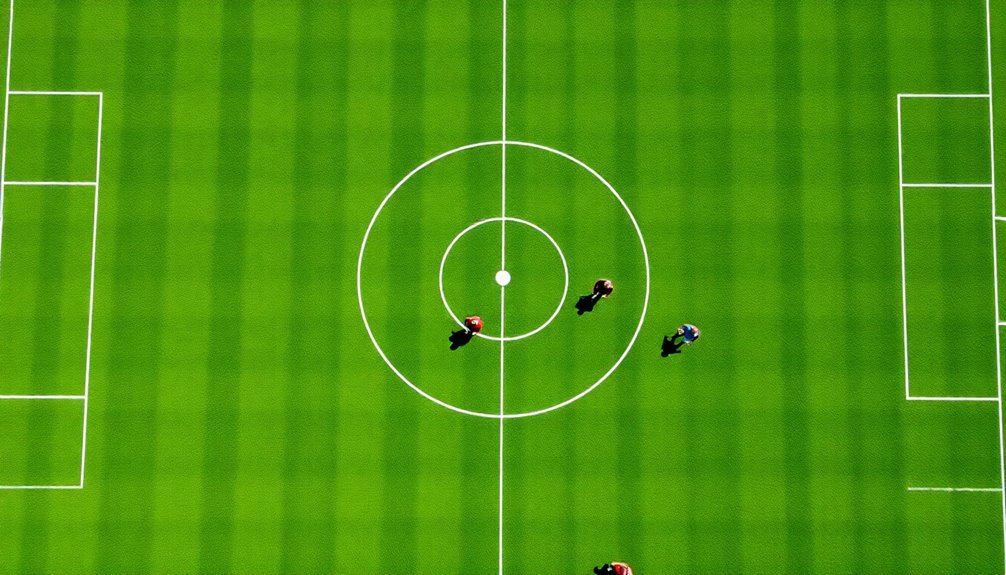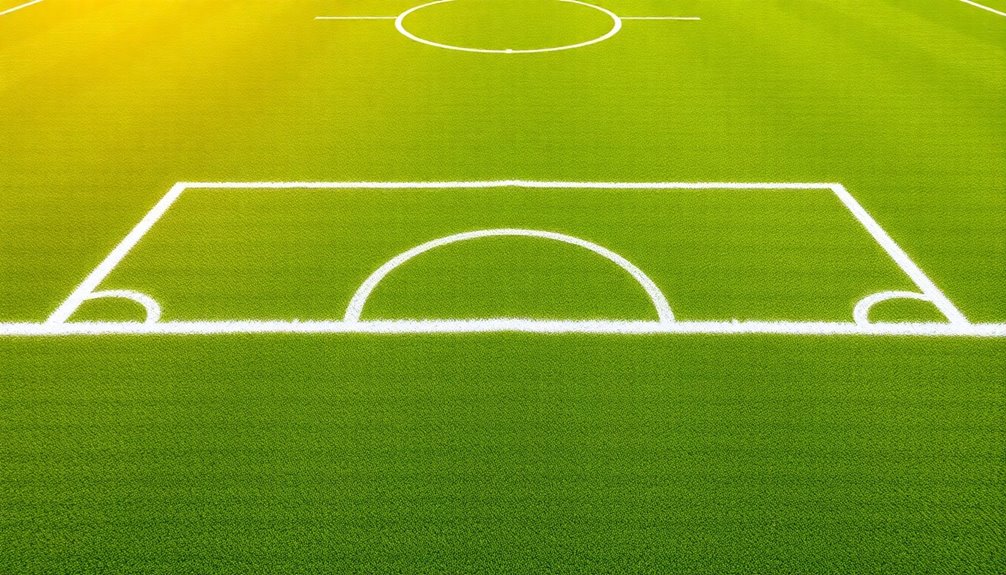
Understanding Soccer Field Lines for Better Gameplay
February 11, 2025Understanding soccer field lines is essential for enhancing your gameplay. Each line and area has specific roles; for instance, the penalty area allows goalies to use their hands and can lead to penalty kicks. Knowing the importance of the center circle during kickoffs and how corner marks determine play can give you an edge. Sidelines define play length, while the halfway line aids in positioning. When you master these markings, you'll improve your tactical moves and decision-making on the field. Keep exploring to uncover how these lines shape your game strategy and elevate your performance.
Importance of Field Lines
Understanding the importance of field lines is essential for anyone involved in soccer. These lines aren't just markings; they define the game. The sidelines, or touch lines, determine the length of the playing field. When the ball crosses these lines, it's out of play, leading to throw-ins or free kicks.
The halfway line is equally significant, dividing the field into two halves and guiding player positioning during kickoffs and offside decisions. Additionally, players must be aware of the consequences of fouls occurring near the goal area, which can heavily influence game strategy.
The center circle plays a key role at the start of the game, ensuring that opposing players maintain a distance of 10 yards during kickoffs. This promotes fair play and order right from the beginning.
Then, there's the penalty area, or 18-yard box, which is critical for identifying fouls that lead to penalty kicks. Players must be aware of their positioning to avoid giving away such important opportunities.
The goal area, or 6-yard box, is where goal kicks are taken, influencing defensive and offensive strategies. Understanding the offside rule is vital for players to avoid penalties and maintain the flow of the game.
Goal Area and Its Role
The goal area, or 6-yard box, plays a vital role in soccer, especially during goal kicks. You must take the kick from within this area or its line, ensuring the ball's stationary position. Understanding this area helps you grasp how restarts influence the flow of the game. Additionally, the goalkeeper's role within this area is crucial for managing defense and initiating attacks. The area also allows the goalkeeper to handle the ball with their hands, providing a significant advantage in defensive plays. Furthermore, the positioning within the penalty box can greatly affect the outcome of scoring opportunities, as it serves as a critical zone for both attackers and defenders.
Goal Kick Procedure
When a goal kick is taken, it happens from within the goal area, also known as the 6-yard box, which extends 6 yards from the goal line. The ball must be stationary on the ground before you kick it.
As a player, you need to remember that opponents must stay outside the penalty area until the ball is in play. This rule helps guarantee that they don't interfere with your goal kick.
Once you kick the ball and it clearly moves, it's considered in play. Importantly, you can't touch it again until another player has played it.
While you can score a direct goal from a goal kick, be aware that if an own goal occurs, it results in a corner kick for the opposing team.
If your goal kick is taken with the ball moving or from the wrong spot, you'll have to retake it. Repeated mistakes can lead to disciplinary actions against you, so pay attention to the rules.
Mastering the goal kick procedure not only helps your team maintain control but also sets the stage for effective gameplay.
Importance of Goal Area
A well-defined goal area plays an essential role in maintaining order and fairness during a soccer match. This rectangular zone, also known as the 6-yard box, is vital for regulating specific actions related to goal kicks and goalkeeper movements.
Understanding its importance can enhance your gameplay considerably. Here are four key points about the goal area:
- Goal Kick Execution: Goal kicks must be taken from within the goal area, guaranteeing the ball is stationary before you kick it.
- Positioning of Opposing Players: During a goal kick, opposing players must stay outside the penalty area, which helps maintain fairness and order.
- Flexibility for the Kicker: You can take a goal kick from any point within the goal area, giving you strategic options.
- Avoiding Infringements: Knowing the dimensions and regulations of the goal area is essential to avoid fouls and guarantee effective goal kick execution.
Understanding the Penalty Area

The penalty area, or 18-yard box, measures 16.5 meters from the goal line and plays an essential role in gameplay. Inside this zone, the goalkeeper can use their hands, while any fouls committed by the attacking team lead to a penalty kick for the defense. Understanding these dimensions and rules is vital for grasping how the game unfolds in high-pressure situations. Additionally, statistics show a high percentage of goals scored from penalty kicks, highlighting the importance of this area in determining match outcomes. Often, decisions regarding handball offenses within this zone can significantly impact the flow of the game and the strategies employed by both teams. The penalty area dimensions are crucial for players to understand to avoid unintentional fouls.
Penalty Area Dimensions
What defines the space where some of the most important moments in soccer occur? It's the penalty area, often referred to as the 18-yard box. Understanding its dimensions is essential for players and fans alike.
Here's a quick overview of the penalty area:
- Length: The penalty area extends 16.5 meters (18 yards) from the goal line.
- Width: It measures 40.3 meters (44 yards) across.
- Penalty Spot: Located 11 meters (12 yards) from the goal line, this is where penalty kicks are taken.
- Goalkeeper's Zone: Inside the penalty area, the goalkeeper can use their hands to play the ball.
These dimensions are critical for determining when fouls occur and how penalties are awarded.
If an attacking player commits a foul in this area, the defending team gets a penalty kick.
Also, the penalty area defines the limits of the goalkeeper's actions, making it essential for both attacking and defending strategies.
Knowing these details helps you appreciate the game better and understand the significance of every play that happens within this marked space.
Goalkeeper's Role Explained
In soccer, the goalkeeper's role is essential within the penalty area, where they become the last line of defense against opposing attackers. This rectangular zone, also known as the 18-yard box, extends 16.5 meters from the goal line and is where you can use your hands to play the ball.
Your primary responsibility is to protect the goal posts and prevent the ball from crossing the line.
When a foul occurs within the penalty area, it often results in a penalty kick being awarded to the attacking team. This is a critical moment, as the penalty spot is just 11 meters from the goal line, putting you under immense pressure.
You need to assess the situation quickly, as the referee will decide whether a penalty kick or a free kick is warranted based on the severity of the foul.
The Significance of the Penalty Spot
- Distance Matters: All players must remain at least 9.15 meters away from the penalty spot until the kick is taken.
- High Stakes: The success of a penalty kick can hinge on the mental pressure faced by both the shooter and the goalkeeper.
- Fair Play: The area surrounding the penalty spot is essential for maintaining order during the kick, as players must respect designated distances.
- Scoring Opportunities: The penalty spot is a central point for scoring, turning fouls in the penalty area into potential goals.
- Free Kick Knowledge: Understanding the rules and strategies associated with free kicks can enhance a player's overall effectiveness during crucial game moments.
In soccer, mastering the dynamics of the penalty spot can greatly enhance your understanding of gameplay and strategy.
Center Circle and Kickoff Procedures

When the game starts or a goal is scored, the center circle plays an essential role in the kickoff process. You need to guarantee that all opposing players stay outside this 10-yard radius until the ball is in play. This regulation helps maintain order and fairness at the beginning of each play. Additionally, the opposing players must remain outside the center circle until the ball is in play, ensuring a fair kickoff procedure. A kickoff is also a moment to restart the match after a goal, emphasizing the importance of proper procedures to enhance gameplay. Proper positioning of players during a kickoff can also help in executing tackles effectively as the game progresses.
Kickoff Positioning Regulations
Kickoff positioning regulations play a crucial role in guaranteeing fair play at the start of a game or after a goal. Understanding these rules helps you and your teammates execute the kickoff effectively. Here's what you need to know:
- Player Positioning: All players from the team taking the kick must be inside their own half of the field.
- Opposing Players: The opponents must remain outside the center circle until the ball is in play.
- Ball in Play: The ball is considered in play as soon as it's kicked and moves forward.
- Retaking the Kick: If the ball doesn't move forward during the kickoff, the referee will stop play, requiring a retake.
These regulations guarantee that players are positioned correctly, promoting fairness and clarity.
Remember, during the kickoff, no player can be offside, regardless of where they're on the field. Following these rules makes the kickoff smoother and helps maintain the game's flow.
Center Circle Functionality
Understanding the center circle's role is essential for executing proper kickoff procedures. The center circle, with a radius of 10 yards, defines the area where players must remain outside during kickoffs. At the start of the match or after a goal, the ball is placed on the center spot for the kickoff. All players from the opposing team must stay outside the center circle until the ball is kicked and clearly moves.
This area serves no function outside of kickoffs, guaranteeing that players maintain proper positioning to prevent encroachment during this critical restart. The dimensions of the center circle help maintain order and fairness at the start of play, dictating the required distance between players.
During the kickoff, you must remain stationary within the center circle until the kick is taken. Once the ball is kicked, it's considered in play, allowing you and your teammates to advance towards the opposing team.
Adhering to these rules guarantees a smooth and fair restart, setting the tone for effective gameplay. Remember, respecting the center circle is key to maintaining the integrity of the match.
Halfway Line and Offside Rules
At the start of the match, the halfway line plays a vital role in soccer, marking the division between the two teams' territories. Understanding how this line interacts with the offside rule is key to effective gameplay.
Here are four important points to remember regarding the halfway line and offside situations:
- During a kickoff, all players must remain in their own half of the field until the ball is played, ensuring that the kickoff rules are upheld.
- A player can't be offside if they're in their own half when the ball is played, regardless of their position relative to the opponent's goal.
- An attacking player is considered offside if they're closer to the opponent's goal line than both the ball and the second-to-last opponent at the moment the ball is played. This concept is similar to the handball rule which also emphasizes the importance of player positioning.
- The halfway line is essential for maintaining order during restarts and ensuring fair play concerning the offside rule. Additionally, understanding throw-in rules is crucial for managing possession during gameplay. Furthermore, recognizing the significance of kickoff rules can enhance a team's strategy from the very beginning of the match.
Sidelines and End Lines

Soccer gameplay extends beyond the halfway line, with the sidelines and end lines playing significant roles in determining when the ball is in or out of play.
The sidelines, also known as touch lines, run along the length of the soccer field. When the ball crosses these lines, it's considered out of play, leading to a throw-in for the opposing team. You'll need to execute the throw-in using both hands, launching the ball from behind your head.
On the other hand, the end lines, or goal lines, are positioned at each end of the field. They define the area where goals can be scored. If the ball completely crosses the end line without resulting in a goal, you'll face either a goal kick or a corner kick, depending on which team last touched the ball.
According to FIFA regulations, the distance between the two sidelines must be between 45 to 90 meters, while the length between the two end lines should measure between 90 to 120 meters. Understanding these lines enhances your gameplay and strategic decisions on the field.
Corner Marks Explained
Four corner marks are positioned at each corner of the soccer field, serving as the starting points for corner kicks. Each corner mark is a quarter-circle with a radius of 1 yard, extending into the field from the corner flag. Understanding these marks helps you enhance your gameplay and take advantage of scoring opportunities.
When a corner kick is awarded, remember these key points:
- Placement: The ball must be placed within the corner arc at the nearest corner mark before being kicked.
- Distance: Opposing players must remain at least 10 yards away from the corner mark until the ball is in play.
- Execution: The player taking the corner kick can choose to pass, cross, or shoot directly at the goal.
- Strategy: Effective use of corner kicks can create valuable scoring opportunities, so coordinate with teammates to maximize impact.
Field Dimensions and Markings

Understanding the dimensions and markings of a soccer field is fundamental for any player aiming to enhance their performance.
Professional soccer field dimensions range from 90 to 120 meters in length and 45 to 90 meters in width, with FIFA recommending a standard size of 105 meters by 68 meters. Familiarizing yourself with these measurements helps you navigate the field effectively.
Key markings, like the halfway line, play an essential role in determining offside positions and player movement during restarts. The center circle, with a radius of 10 yards, guarantees that opposing players maintain a proper distance during kickoffs, which is crucial for fair play.
The penalty area, or the 18-yard box, extends 16.5 meters from the goal line, while the goal area, known as the 6-yard box, stretches 5.5 meters. Understanding these areas is significant, especially when considering fouls and goalkeeping situations.
Finally, corner marks at each corner of the field indicate where corner kicks are taken, emphasizing the importance of precise field markings in gameplay initiation.
Mastering these dimensions and markings can greatly improve your strategic approach on the field.
Historical Context of Field Lines
Throughout the evolution of the game, field lines have undergone significant changes that reflect the sport's rich history. Originally, various football codes had different field markings, but the establishment of the Football Association in 1863 standardized many aspects, including these vital lines.
Here are four key developments in the historical context of field lines:
- Standardization: In 1863, the Football Association created uniform field dimensions and markings, setting the foundation for modern soccer.
- Goal Kick Codification: The term "goal kick" was officially adopted in 1890, clarifying rules related to field markings.
- Introduction of Areas: The early 1900s saw the addition of the "goal area" and "penalty area," refining gameplay related to penalty kicks and goal kicks.
- FIFA Recommendations: FIFA later recommended a standard field size of 105 meters by 68 meters, ensuring consistency across professional play.
These changes not only shaped the way you experience the game but also established essential rules that govern player positioning and fair play, making soccer a more structured and exciting sport.
Conclusion
In soccer, understanding field lines is like mastering the notes of a beautiful symphony; each mark plays an essential role in the game's harmony. By grasping the significance of areas like the penalty box and center circle, you're better equipped to navigate the match's rhythm. Whether you're a player or a fan, recognizing these elements enhances your appreciation of the sport. Embrace the lines, and you'll reveal a deeper connection to the beautiful game.


